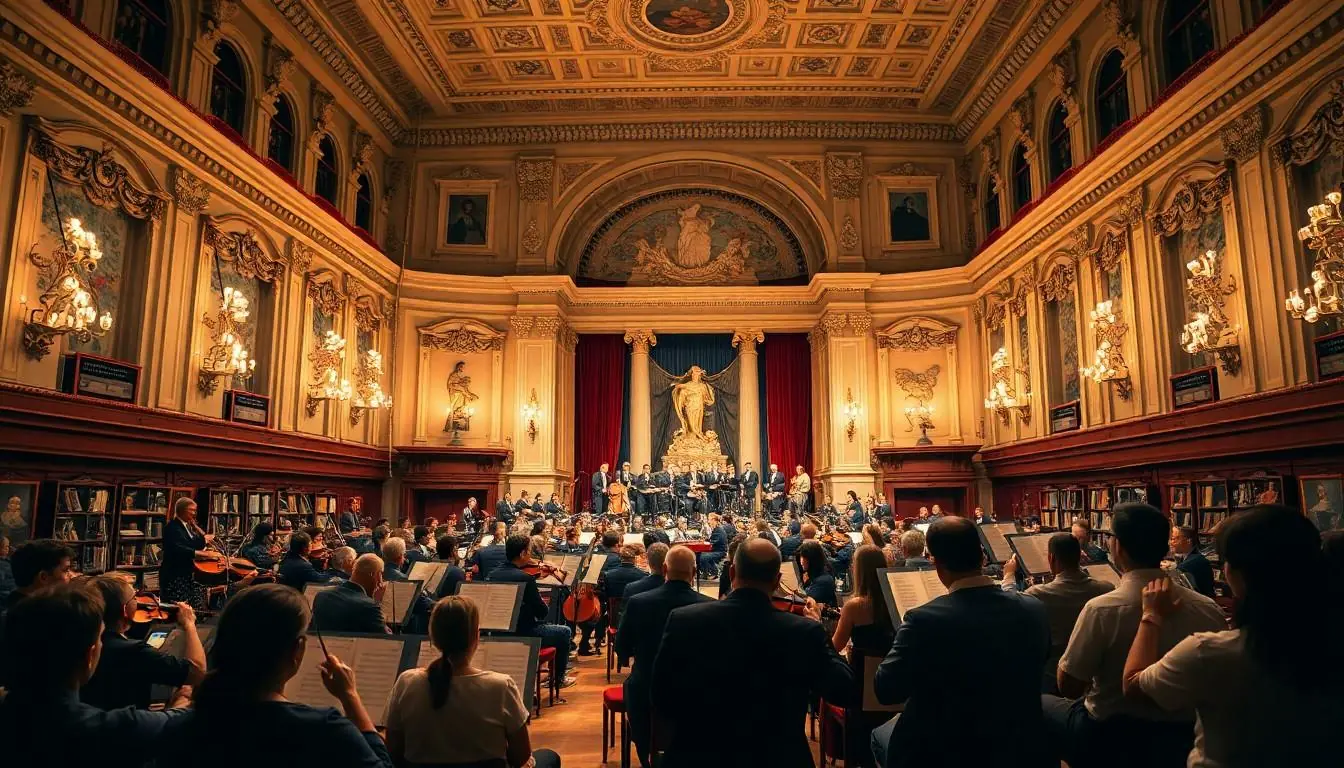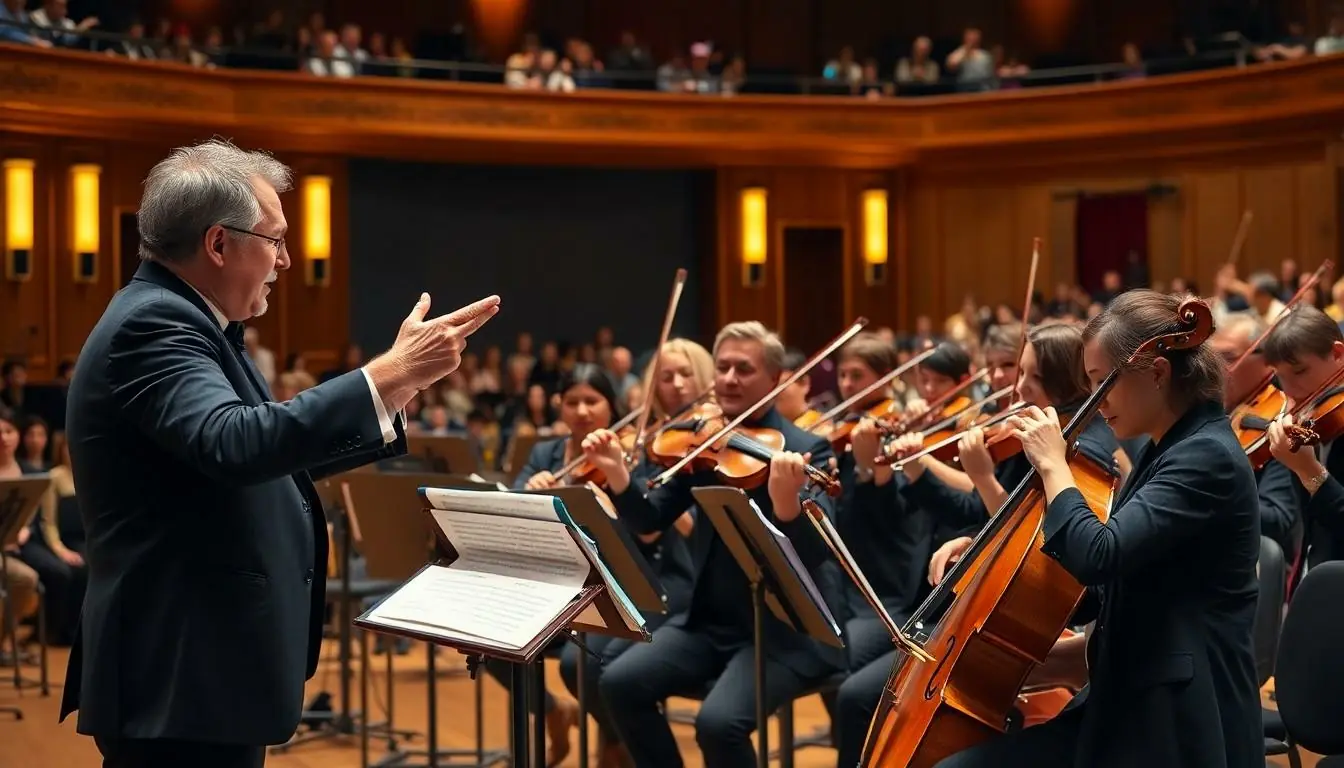Classical music might seem like a stuffy old art form reserved for tuxedo-clad concertgoers, but it’s got more surprises than a magician’s hat. From composers who’d rather party than practice to symphonies that were once considered scandalous, the world of classical music is anything but boring. It’s time to tune in and discover the quirky side of this timeless genre.
Table of Contents
ToggleOverview of Classical Music Facts
Classical music encompasses a rich history and diverse range of styles. Originating in the Western tradition, classical music spans from the medieval era to contemporary compositions. Iconic composers like Bach, Mozart, and Beethoven shaped the genre, each bringing unique elements to their work.
An interesting fact: most classical music pieces require significant collaboration among musicians and conductors. Chamber orchestras and large symphonies frequently perform in various settings, from concert halls to outdoor festivals. Discrepancies often arise in interpretations, leading to vibrant performances that can differ dramatically from one another.
Did you know that classical music has health benefits? Research shows that listening to classical melodies can reduce stress, improve concentration, and enhance sleep quality. Some studies even suggest that exposing children to classical music during formative years can aid in cognitive development.
Audience interactions play a crucial role in classical music appreciation. Engaging concerts often involve thematic programming and visual elements, inviting listeners to connect with the music on a deeper level. Furthermore, many contemporary composers experiment with merging genres, expanding the boundaries of classical music.
Exploring notable trends reveals that classical music’s popularity remains steady. Streaming platforms have made access to a wider audience easier, introducing young listeners to timeless masterpieces. Live performances continue to draw crowds, demonstrating an enduring interest in this genre.
Historical Insights

Classical music boasts a rich and varied history, shaped by numerous cultural influences and artistic movements. This section delves into its origins and the contributions of notable composers.
Origins of Classical Music
Classical music traces its roots back to the medieval era, approximately the 9th century. Early composers like Hildegard von Bingen laid foundational techniques. The Renaissance period, spanning the 14th to 17th centuries, witnessed the emergence of polyphony, enriching musical complexity. The Baroque era followed, from 1600 to 1750, introducing ornamentation and dramatic expression. This period produced influential works, establishing new forms like the concerto and opera. The Classical and Romantic eras further evolved these concepts, presenting a wide array of styles and innovations that resonate with modern audiences.
Notable Composers and Their Contributions
Johann Sebastian Bach significantly advanced musical complexity through intricate fugues and concertos. His works serve as benchmarks in composition and harmony. Wolfgang Amadeus Mozart, known for his elegance and lyrical melodies, contributed extensively across various genres, from symphonies to operas. His ability to blend emotion with technical precision remains unmatched. Ludwig van Beethoven revolutionized music by incorporating personal expression and expanding forms. His symphonies, especially the Fifth and Ninth, laid groundwork for future composers. Collectively, these musicians shaped classical music’s landscape, influencing generations that followed.
Characteristics of Classical Music
Classical music encompasses a variety of features that contribute to its complexity and appeal. It combines technical precision with emotional depth, creating a multidimensional art form that captivates audiences across generations.
Key Elements and Structure
Melody forms the backbone of classical music, often creating memorable themes. Harmony adds richness, providing a foundation for the melody to develop. Rhythm drives the piece, varying in tempo and flow to evoke different emotions. Composers frequently utilize dynamics to enhance expressive qualities, transitioning between loud and soft passages to keep listeners engaged. Form structures such as sonata-allegro, rondo, and theme and variations organize compositions, allowing for contrast and development within a piece. These elements work together to create a dynamic listening experience.
Different Eras of Classical Music
Classical music emerged through distinct eras, each characterized by unique styles and innovations. The Medieval period featured monophonic textures, while the Renaissance introduced polyphony, enriching the musical landscape. The Baroque era marked a shift toward ornamentation and emotional expression with composers like Bach and Vivaldi. The Classical period focused on clarity and balance, with Mozart exemplifying this transition. Romanticism embraced individualism and dramatic narratives, showcasing composers like Beethoven and Chopin. In the 20th century, avant-garde techniques challenged traditional boundaries, reflecting societal changes. These eras together illustrate the evolution of classical music and its enduring legacy.
Impact on Culture and Society
Classical music significantly influences culture and society. It shapes artistic expressions and experiences across various platforms.
Classical Music in Popular Media
Film scores often feature classical compositions to evoke emotions. Directors like Stanley Kubrick effectively used classical music to enhance scenes in films such as “2001: A Space Odyssey.” Popular shows also incorporate these pieces, helping to bring classical works to new audiences. Streaming services frequently showcase playlists that blend classical music with contemporary genres. This accessibility fosters a broader appreciation, as listeners discover the beauty of classics alongside modern hits.
Influence on Modern Music Genres
Various modern music genres draw inspiration from classical music. Rock bands often incorporate orchestral elements into their arrangements, adding depth and complexity. Hip-hop producers sample classical pieces, creating unique soundscapes that resonate with listeners. Electronic music also connects with classical through intricate melodies and harmonies. These influences demonstrate classical music’s timeless relevance while forging new paths in contemporary music.
Classical music’s vibrant history and diverse styles reveal a genre that’s far from elitist. From its medieval roots to contemporary compositions it continues to surprise and engage audiences. The collaboration between musicians and conductors enhances the performances while the emotional depth captivates listeners across generations.
Its impact on culture and modern music is undeniable. Classical pieces enrich film scores and inspire new genres demonstrating its timeless relevance. As streaming platforms and live performances draw in younger audiences classical music’s legacy remains strong and continues to evolve. Embracing the unconventional aspects of this genre opens up a world of enjoyment and appreciation for all.



